Business Environment Analysis: Sainsbury's Operations and Factors
VerifiedAdded on 2020/12/29
|12
|3141
|413
Report
AI Summary
This report provides a comprehensive analysis of the business environment, focusing on Sainsbury's operations. It begins with an introduction to the business environment and an overview of different types of organizations including public, private, and voluntary sectors. The report then delves into stakeholder mapping, identifying key internal and external stakeholders and their influence on Sainsbury's. The core of the report examines the impact of micro and macro environmental factors on Sainsbury's operations, utilizing PESTEL, SWOT, and Porter's Five Forces models to assess political, economic, social, technological, environmental, and legal factors. The SWOT analysis evaluates Sainsbury's strengths, weaknesses, opportunities, and threats. The Porter's Five Forces model analyzes the competitive environment, including rivalry among competitors, potential entrants, and substitute products. The report concludes with a summary of findings and references.
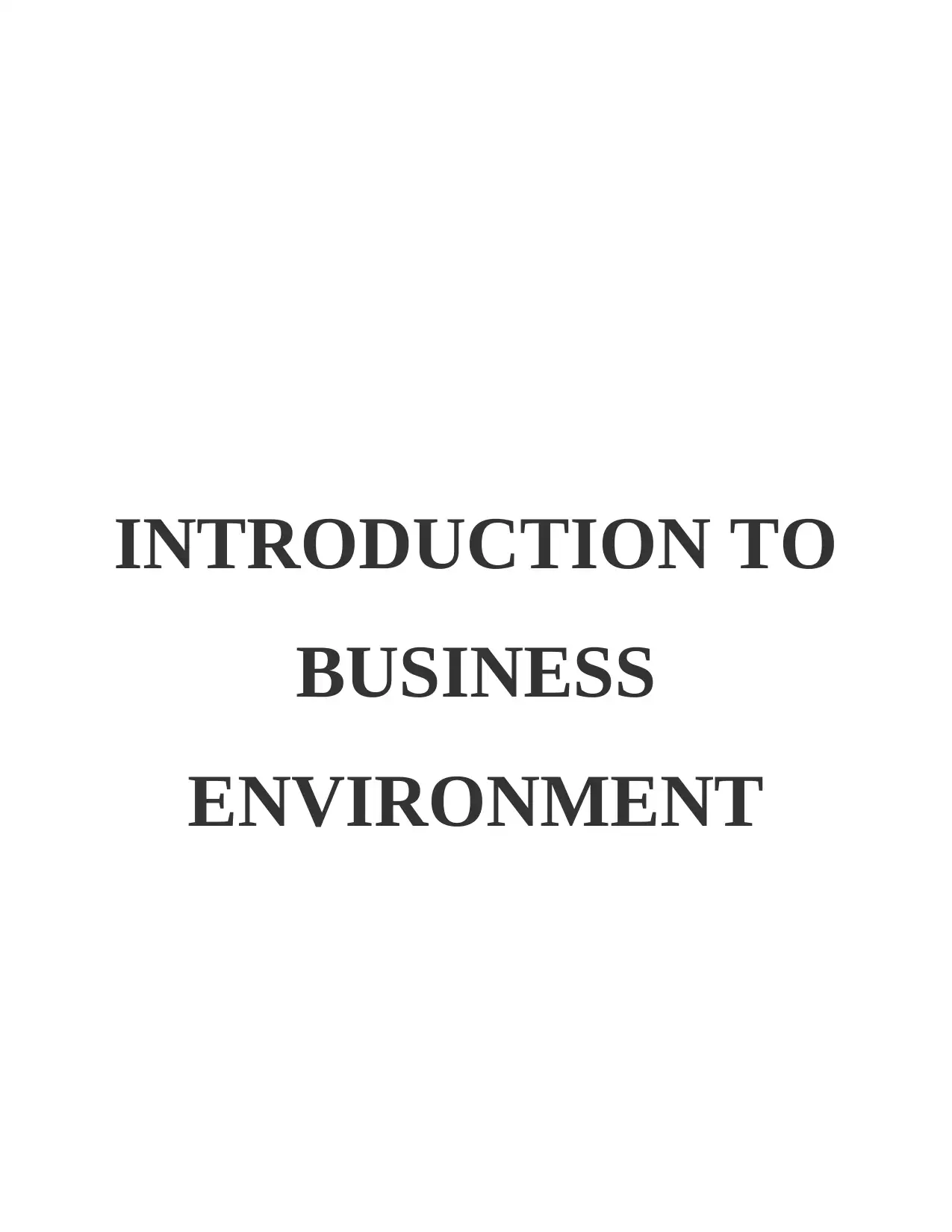
INTRODUCTION TO
BUSINESS
ENVIRONMENT
BUSINESS
ENVIRONMENT
Paraphrase This Document
Need a fresh take? Get an instant paraphrase of this document with our AI Paraphraser
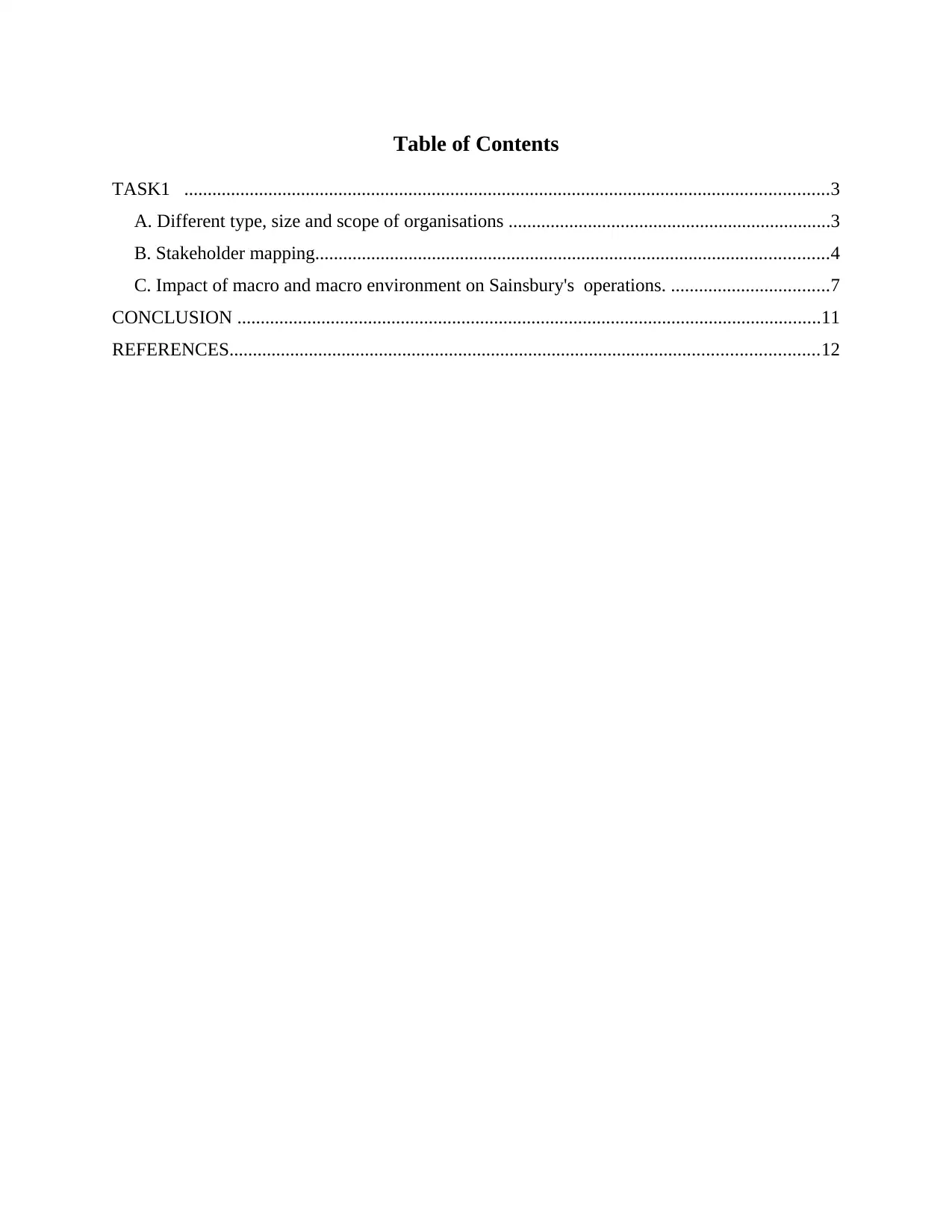
Table of Contents
TASK1 ..........................................................................................................................................3
A. Different type, size and scope of organisations .....................................................................3
B. Stakeholder mapping..............................................................................................................4
C. Impact of macro and macro environment on Sainsbury's operations. ..................................7
CONCLUSION .............................................................................................................................11
REFERENCES..............................................................................................................................12
TASK1 ..........................................................................................................................................3
A. Different type, size and scope of organisations .....................................................................3
B. Stakeholder mapping..............................................................................................................4
C. Impact of macro and macro environment on Sainsbury's operations. ..................................7
CONCLUSION .............................................................................................................................11
REFERENCES..............................................................................................................................12
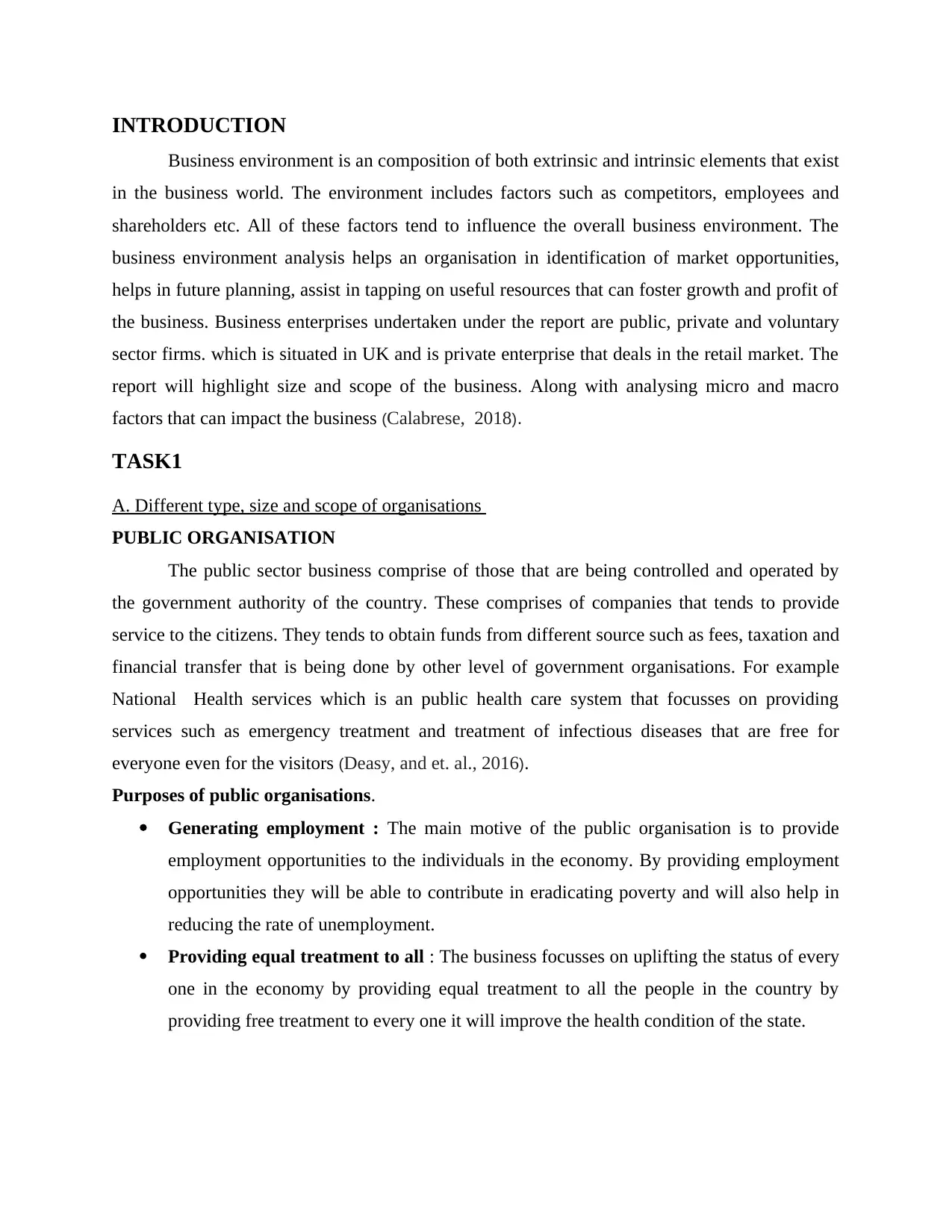
INTRODUCTION
Business environment is an composition of both extrinsic and intrinsic elements that exist
in the business world. The environment includes factors such as competitors, employees and
shareholders etc. All of these factors tend to influence the overall business environment. The
business environment analysis helps an organisation in identification of market opportunities,
helps in future planning, assist in tapping on useful resources that can foster growth and profit of
the business. Business enterprises undertaken under the report are public, private and voluntary
sector firms. which is situated in UK and is private enterprise that deals in the retail market. The
report will highlight size and scope of the business. Along with analysing micro and macro
factors that can impact the business (Calabrese, 2018).
TASK1
A. Different type, size and scope of organisations
PUBLIC ORGANISATION
The public sector business comprise of those that are being controlled and operated by
the government authority of the country. These comprises of companies that tends to provide
service to the citizens. They tends to obtain funds from different source such as fees, taxation and
financial transfer that is being done by other level of government organisations. For example
National Health services which is an public health care system that focusses on providing
services such as emergency treatment and treatment of infectious diseases that are free for
everyone even for the visitors (Deasy, and et. al., 2016).
Purposes of public organisations.
Generating employment : The main motive of the public organisation is to provide
employment opportunities to the individuals in the economy. By providing employment
opportunities they will be able to contribute in eradicating poverty and will also help in
reducing the rate of unemployment.
Providing equal treatment to all : The business focusses on uplifting the status of every
one in the economy by providing equal treatment to all the people in the country by
providing free treatment to every one it will improve the health condition of the state.
Business environment is an composition of both extrinsic and intrinsic elements that exist
in the business world. The environment includes factors such as competitors, employees and
shareholders etc. All of these factors tend to influence the overall business environment. The
business environment analysis helps an organisation in identification of market opportunities,
helps in future planning, assist in tapping on useful resources that can foster growth and profit of
the business. Business enterprises undertaken under the report are public, private and voluntary
sector firms. which is situated in UK and is private enterprise that deals in the retail market. The
report will highlight size and scope of the business. Along with analysing micro and macro
factors that can impact the business (Calabrese, 2018).
TASK1
A. Different type, size and scope of organisations
PUBLIC ORGANISATION
The public sector business comprise of those that are being controlled and operated by
the government authority of the country. These comprises of companies that tends to provide
service to the citizens. They tends to obtain funds from different source such as fees, taxation and
financial transfer that is being done by other level of government organisations. For example
National Health services which is an public health care system that focusses on providing
services such as emergency treatment and treatment of infectious diseases that are free for
everyone even for the visitors (Deasy, and et. al., 2016).
Purposes of public organisations.
Generating employment : The main motive of the public organisation is to provide
employment opportunities to the individuals in the economy. By providing employment
opportunities they will be able to contribute in eradicating poverty and will also help in
reducing the rate of unemployment.
Providing equal treatment to all : The business focusses on uplifting the status of every
one in the economy by providing equal treatment to all the people in the country by
providing free treatment to every one it will improve the health condition of the state.
⊘ This is a preview!⊘
Do you want full access?
Subscribe today to unlock all pages.

Trusted by 1+ million students worldwide
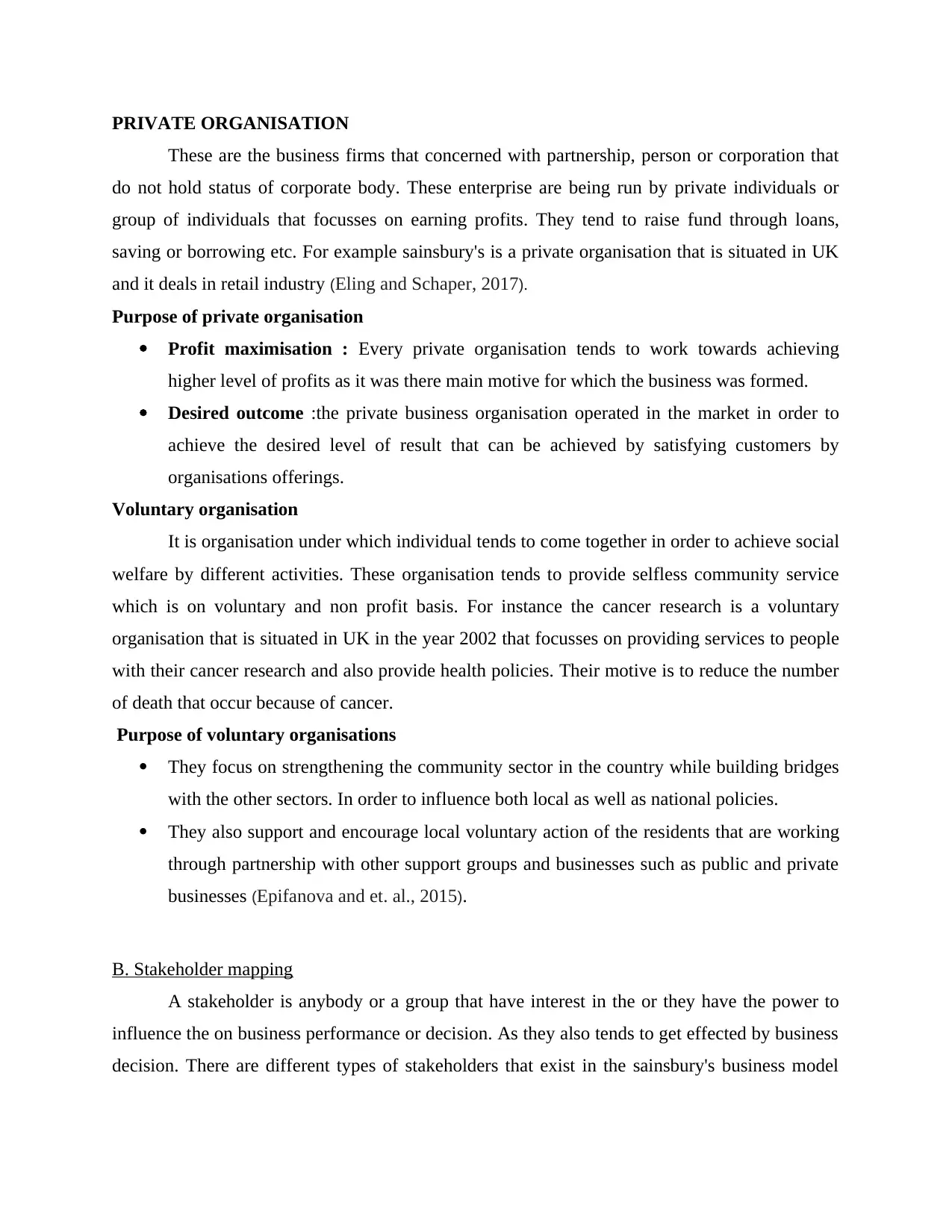
PRIVATE ORGANISATION
These are the business firms that concerned with partnership, person or corporation that
do not hold status of corporate body. These enterprise are being run by private individuals or
group of individuals that focusses on earning profits. They tend to raise fund through loans,
saving or borrowing etc. For example sainsbury's is a private organisation that is situated in UK
and it deals in retail industry (Eling and Schaper, 2017).
Purpose of private organisation
Profit maximisation : Every private organisation tends to work towards achieving
higher level of profits as it was there main motive for which the business was formed.
Desired outcome :the private business organisation operated in the market in order to
achieve the desired level of result that can be achieved by satisfying customers by
organisations offerings.
Voluntary organisation
It is organisation under which individual tends to come together in order to achieve social
welfare by different activities. These organisation tends to provide selfless community service
which is on voluntary and non profit basis. For instance the cancer research is a voluntary
organisation that is situated in UK in the year 2002 that focusses on providing services to people
with their cancer research and also provide health policies. Their motive is to reduce the number
of death that occur because of cancer.
Purpose of voluntary organisations
They focus on strengthening the community sector in the country while building bridges
with the other sectors. In order to influence both local as well as national policies.
They also support and encourage local voluntary action of the residents that are working
through partnership with other support groups and businesses such as public and private
businesses (Epifanova and et. al., 2015).
B. Stakeholder mapping
A stakeholder is anybody or a group that have interest in the or they have the power to
influence the on business performance or decision. As they also tends to get effected by business
decision. There are different types of stakeholders that exist in the sainsbury's business model
These are the business firms that concerned with partnership, person or corporation that
do not hold status of corporate body. These enterprise are being run by private individuals or
group of individuals that focusses on earning profits. They tend to raise fund through loans,
saving or borrowing etc. For example sainsbury's is a private organisation that is situated in UK
and it deals in retail industry (Eling and Schaper, 2017).
Purpose of private organisation
Profit maximisation : Every private organisation tends to work towards achieving
higher level of profits as it was there main motive for which the business was formed.
Desired outcome :the private business organisation operated in the market in order to
achieve the desired level of result that can be achieved by satisfying customers by
organisations offerings.
Voluntary organisation
It is organisation under which individual tends to come together in order to achieve social
welfare by different activities. These organisation tends to provide selfless community service
which is on voluntary and non profit basis. For instance the cancer research is a voluntary
organisation that is situated in UK in the year 2002 that focusses on providing services to people
with their cancer research and also provide health policies. Their motive is to reduce the number
of death that occur because of cancer.
Purpose of voluntary organisations
They focus on strengthening the community sector in the country while building bridges
with the other sectors. In order to influence both local as well as national policies.
They also support and encourage local voluntary action of the residents that are working
through partnership with other support groups and businesses such as public and private
businesses (Epifanova and et. al., 2015).
B. Stakeholder mapping
A stakeholder is anybody or a group that have interest in the or they have the power to
influence the on business performance or decision. As they also tends to get effected by business
decision. There are different types of stakeholders that exist in the sainsbury's business model
Paraphrase This Document
Need a fresh take? Get an instant paraphrase of this document with our AI Paraphraser
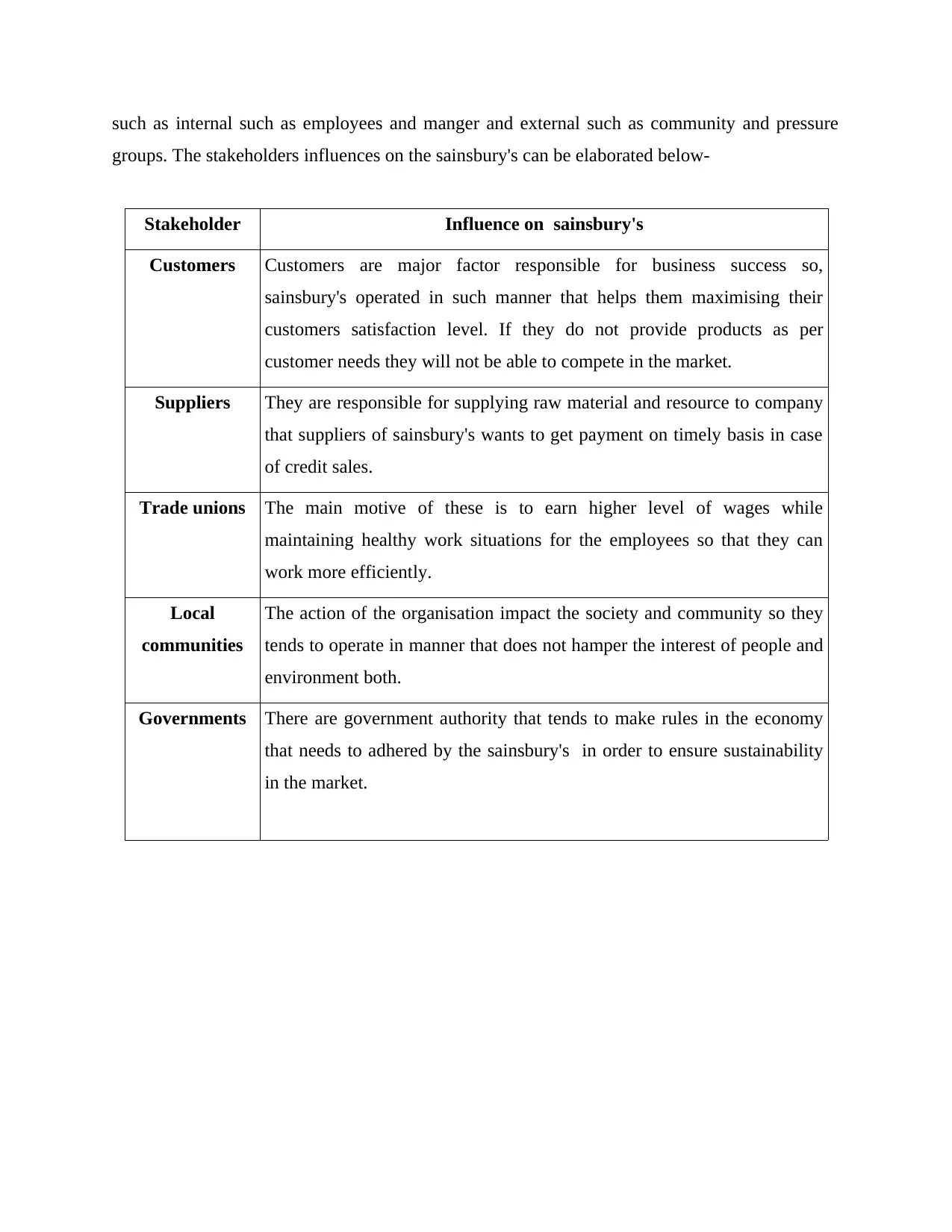
such as internal such as employees and manger and external such as community and pressure
groups. The stakeholders influences on the sainsbury's can be elaborated below-
Stakeholder Influence on sainsbury's
Customers Customers are major factor responsible for business success so,
sainsbury's operated in such manner that helps them maximising their
customers satisfaction level. If they do not provide products as per
customer needs they will not be able to compete in the market.
Suppliers They are responsible for supplying raw material and resource to company
that suppliers of sainsbury's wants to get payment on timely basis in case
of credit sales.
Trade unions The main motive of these is to earn higher level of wages while
maintaining healthy work situations for the employees so that they can
work more efficiently.
Local
communities
The action of the organisation impact the society and community so they
tends to operate in manner that does not hamper the interest of people and
environment both.
Governments There are government authority that tends to make rules in the economy
that needs to adhered by the sainsbury's in order to ensure sustainability
in the market.
groups. The stakeholders influences on the sainsbury's can be elaborated below-
Stakeholder Influence on sainsbury's
Customers Customers are major factor responsible for business success so,
sainsbury's operated in such manner that helps them maximising their
customers satisfaction level. If they do not provide products as per
customer needs they will not be able to compete in the market.
Suppliers They are responsible for supplying raw material and resource to company
that suppliers of sainsbury's wants to get payment on timely basis in case
of credit sales.
Trade unions The main motive of these is to earn higher level of wages while
maintaining healthy work situations for the employees so that they can
work more efficiently.
Local
communities
The action of the organisation impact the society and community so they
tends to operate in manner that does not hamper the interest of people and
environment both.
Governments There are government authority that tends to make rules in the economy
that needs to adhered by the sainsbury's in order to ensure sustainability
in the market.
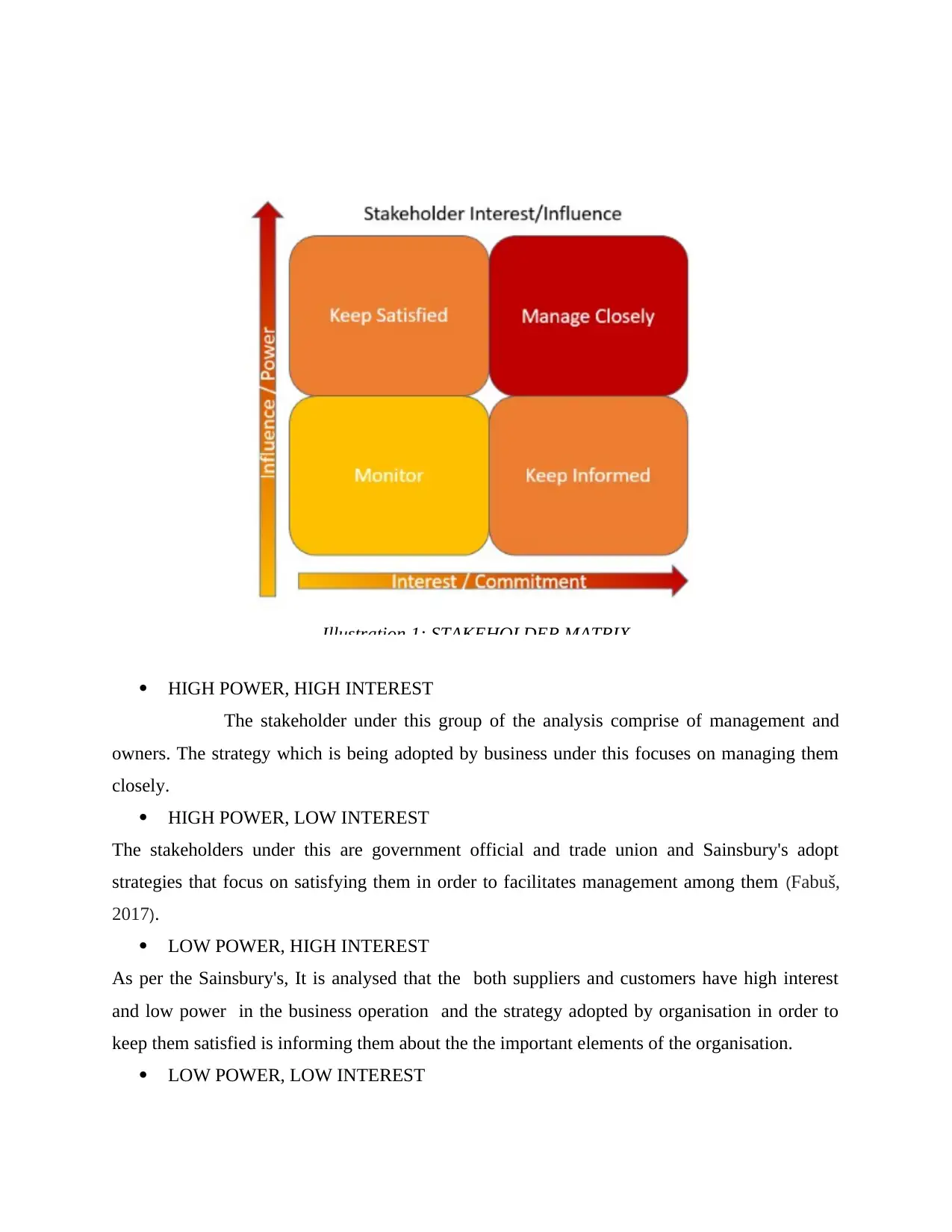
HIGH POWER, HIGH INTEREST
The stakeholder under this group of the analysis comprise of management and
owners. The strategy which is being adopted by business under this focuses on managing them
closely.
HIGH POWER, LOW INTEREST
The stakeholders under this are government official and trade union and Sainsbury's adopt
strategies that focus on satisfying them in order to facilitates management among them (Fabuš,
2017).
LOW POWER, HIGH INTEREST
As per the Sainsbury's, It is analysed that the both suppliers and customers have high interest
and low power in the business operation and the strategy adopted by organisation in order to
keep them satisfied is informing them about the the important elements of the organisation.
LOW POWER, LOW INTEREST
Illustration 1: STAKEHOLDER MATRIX
The stakeholder under this group of the analysis comprise of management and
owners. The strategy which is being adopted by business under this focuses on managing them
closely.
HIGH POWER, LOW INTEREST
The stakeholders under this are government official and trade union and Sainsbury's adopt
strategies that focus on satisfying them in order to facilitates management among them (Fabuš,
2017).
LOW POWER, HIGH INTEREST
As per the Sainsbury's, It is analysed that the both suppliers and customers have high interest
and low power in the business operation and the strategy adopted by organisation in order to
keep them satisfied is informing them about the the important elements of the organisation.
LOW POWER, LOW INTEREST
Illustration 1: STAKEHOLDER MATRIX
⊘ This is a preview!⊘
Do you want full access?
Subscribe today to unlock all pages.

Trusted by 1+ million students worldwide
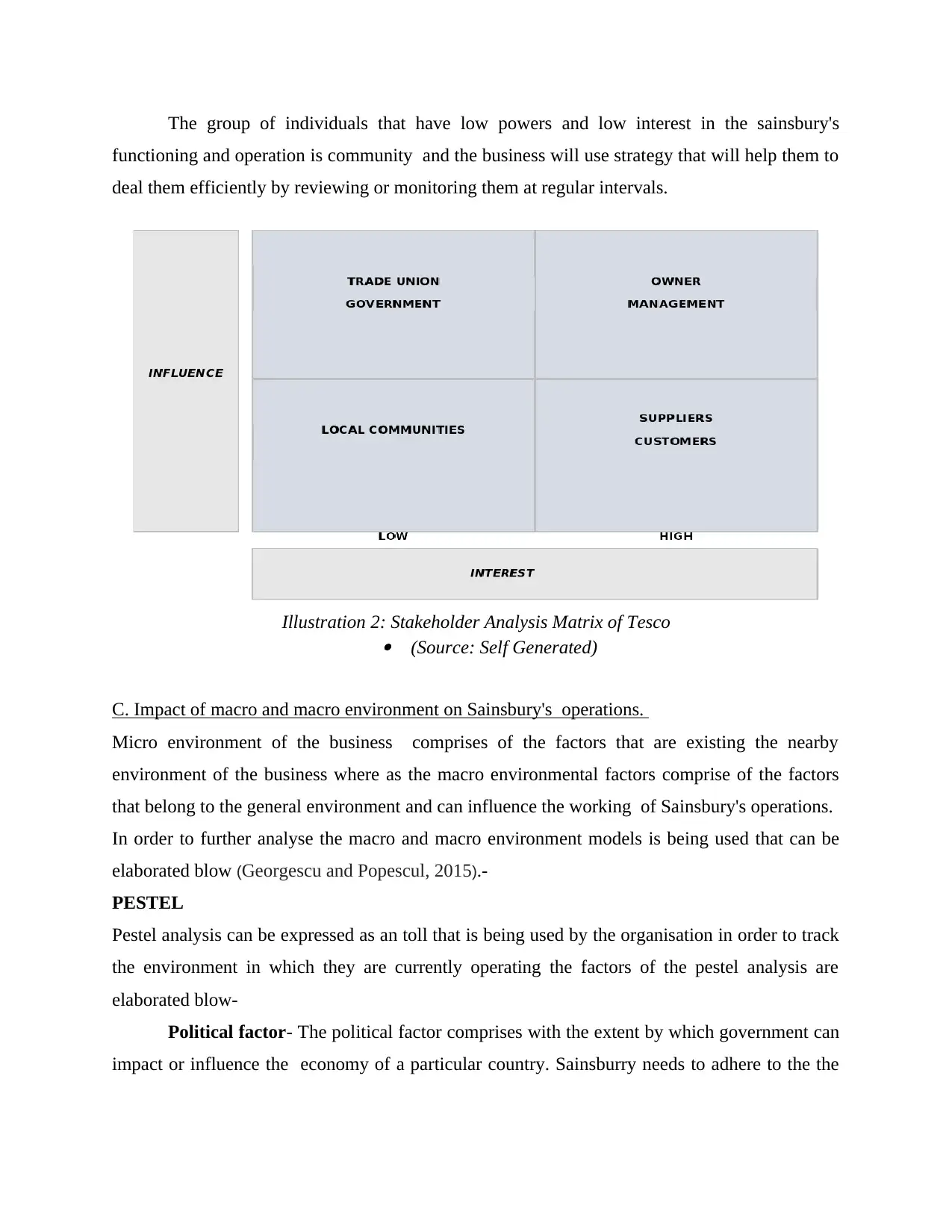
The group of individuals that have low powers and low interest in the sainsbury's
functioning and operation is community and the business will use strategy that will help them to
deal them efficiently by reviewing or monitoring them at regular intervals.
(Source: Self Generated)
C. Impact of macro and macro environment on Sainsbury's operations.
Micro environment of the business comprises of the factors that are existing the nearby
environment of the business where as the macro environmental factors comprise of the factors
that belong to the general environment and can influence the working of Sainsbury's operations.
In order to further analyse the macro and macro environment models is being used that can be
elaborated blow (Georgescu and Popescul, 2015).-
PESTEL
Pestel analysis can be expressed as an toll that is being used by the organisation in order to track
the environment in which they are currently operating the factors of the pestel analysis are
elaborated blow-
Political factor- The political factor comprises with the extent by which government can
impact or influence the economy of a particular country. Sainsburry needs to adhere to the the
Illustration 2: Stakeholder Analysis Matrix of Tesco
functioning and operation is community and the business will use strategy that will help them to
deal them efficiently by reviewing or monitoring them at regular intervals.
(Source: Self Generated)
C. Impact of macro and macro environment on Sainsbury's operations.
Micro environment of the business comprises of the factors that are existing the nearby
environment of the business where as the macro environmental factors comprise of the factors
that belong to the general environment and can influence the working of Sainsbury's operations.
In order to further analyse the macro and macro environment models is being used that can be
elaborated blow (Georgescu and Popescul, 2015).-
PESTEL
Pestel analysis can be expressed as an toll that is being used by the organisation in order to track
the environment in which they are currently operating the factors of the pestel analysis are
elaborated blow-
Political factor- The political factor comprises with the extent by which government can
impact or influence the economy of a particular country. Sainsburry needs to adhere to the the
Illustration 2: Stakeholder Analysis Matrix of Tesco
Paraphrase This Document
Need a fresh take? Get an instant paraphrase of this document with our AI Paraphraser
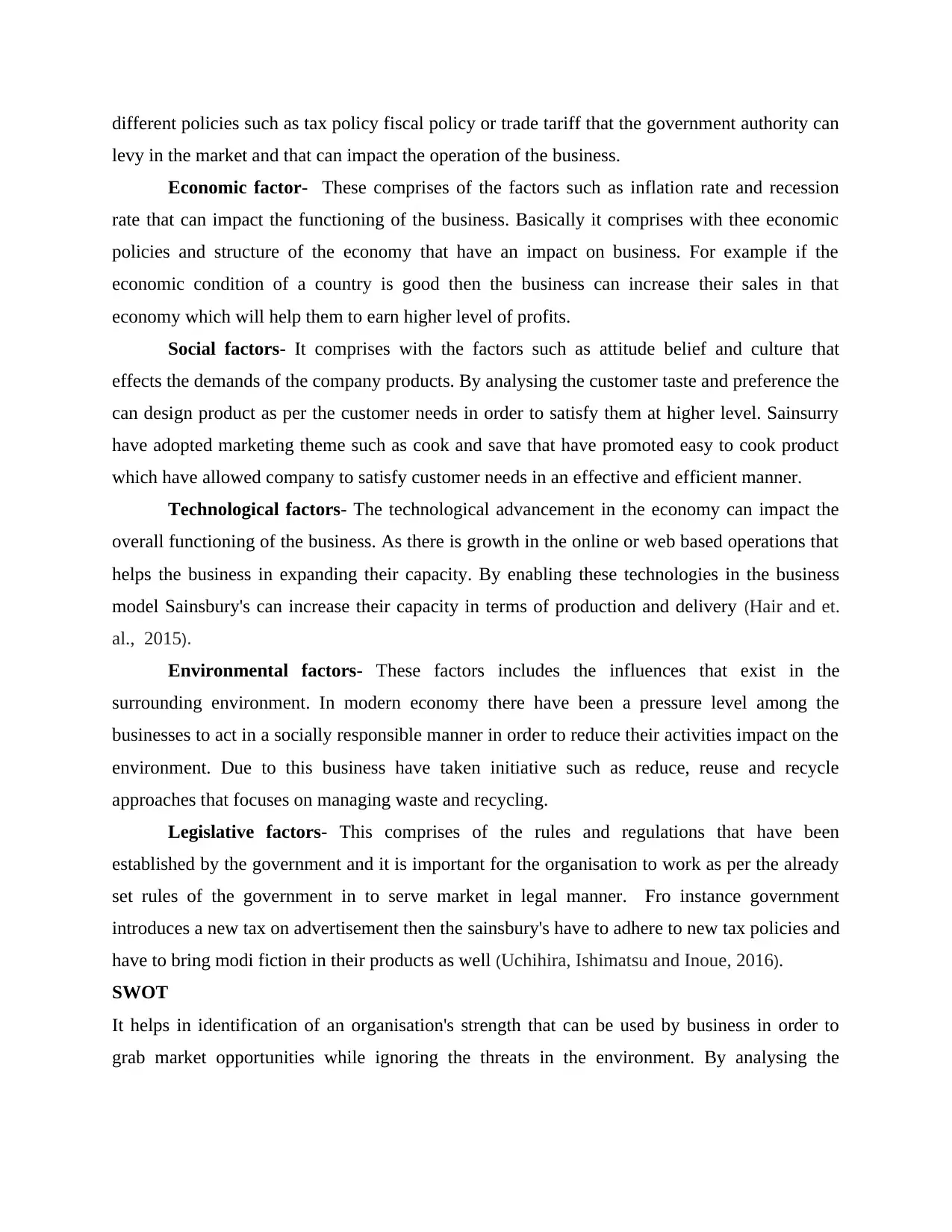
different policies such as tax policy fiscal policy or trade tariff that the government authority can
levy in the market and that can impact the operation of the business.
Economic factor- These comprises of the factors such as inflation rate and recession
rate that can impact the functioning of the business. Basically it comprises with thee economic
policies and structure of the economy that have an impact on business. For example if the
economic condition of a country is good then the business can increase their sales in that
economy which will help them to earn higher level of profits.
Social factors- It comprises with the factors such as attitude belief and culture that
effects the demands of the company products. By analysing the customer taste and preference the
can design product as per the customer needs in order to satisfy them at higher level. Sainsurry
have adopted marketing theme such as cook and save that have promoted easy to cook product
which have allowed company to satisfy customer needs in an effective and efficient manner.
Technological factors- The technological advancement in the economy can impact the
overall functioning of the business. As there is growth in the online or web based operations that
helps the business in expanding their capacity. By enabling these technologies in the business
model Sainsbury's can increase their capacity in terms of production and delivery (Hair and et.
al., 2015).
Environmental factors- These factors includes the influences that exist in the
surrounding environment. In modern economy there have been a pressure level among the
businesses to act in a socially responsible manner in order to reduce their activities impact on the
environment. Due to this business have taken initiative such as reduce, reuse and recycle
approaches that focuses on managing waste and recycling.
Legislative factors- This comprises of the rules and regulations that have been
established by the government and it is important for the organisation to work as per the already
set rules of the government in to serve market in legal manner. Fro instance government
introduces a new tax on advertisement then the sainsbury's have to adhere to new tax policies and
have to bring modi fiction in their products as well (Uchihira, Ishimatsu and Inoue, 2016).
SWOT
It helps in identification of an organisation's strength that can be used by business in order to
grab market opportunities while ignoring the threats in the environment. By analysing the
levy in the market and that can impact the operation of the business.
Economic factor- These comprises of the factors such as inflation rate and recession
rate that can impact the functioning of the business. Basically it comprises with thee economic
policies and structure of the economy that have an impact on business. For example if the
economic condition of a country is good then the business can increase their sales in that
economy which will help them to earn higher level of profits.
Social factors- It comprises with the factors such as attitude belief and culture that
effects the demands of the company products. By analysing the customer taste and preference the
can design product as per the customer needs in order to satisfy them at higher level. Sainsurry
have adopted marketing theme such as cook and save that have promoted easy to cook product
which have allowed company to satisfy customer needs in an effective and efficient manner.
Technological factors- The technological advancement in the economy can impact the
overall functioning of the business. As there is growth in the online or web based operations that
helps the business in expanding their capacity. By enabling these technologies in the business
model Sainsbury's can increase their capacity in terms of production and delivery (Hair and et.
al., 2015).
Environmental factors- These factors includes the influences that exist in the
surrounding environment. In modern economy there have been a pressure level among the
businesses to act in a socially responsible manner in order to reduce their activities impact on the
environment. Due to this business have taken initiative such as reduce, reuse and recycle
approaches that focuses on managing waste and recycling.
Legislative factors- This comprises of the rules and regulations that have been
established by the government and it is important for the organisation to work as per the already
set rules of the government in to serve market in legal manner. Fro instance government
introduces a new tax on advertisement then the sainsbury's have to adhere to new tax policies and
have to bring modi fiction in their products as well (Uchihira, Ishimatsu and Inoue, 2016).
SWOT
It helps in identification of an organisation's strength that can be used by business in order to
grab market opportunities while ignoring the threats in the environment. By analysing the
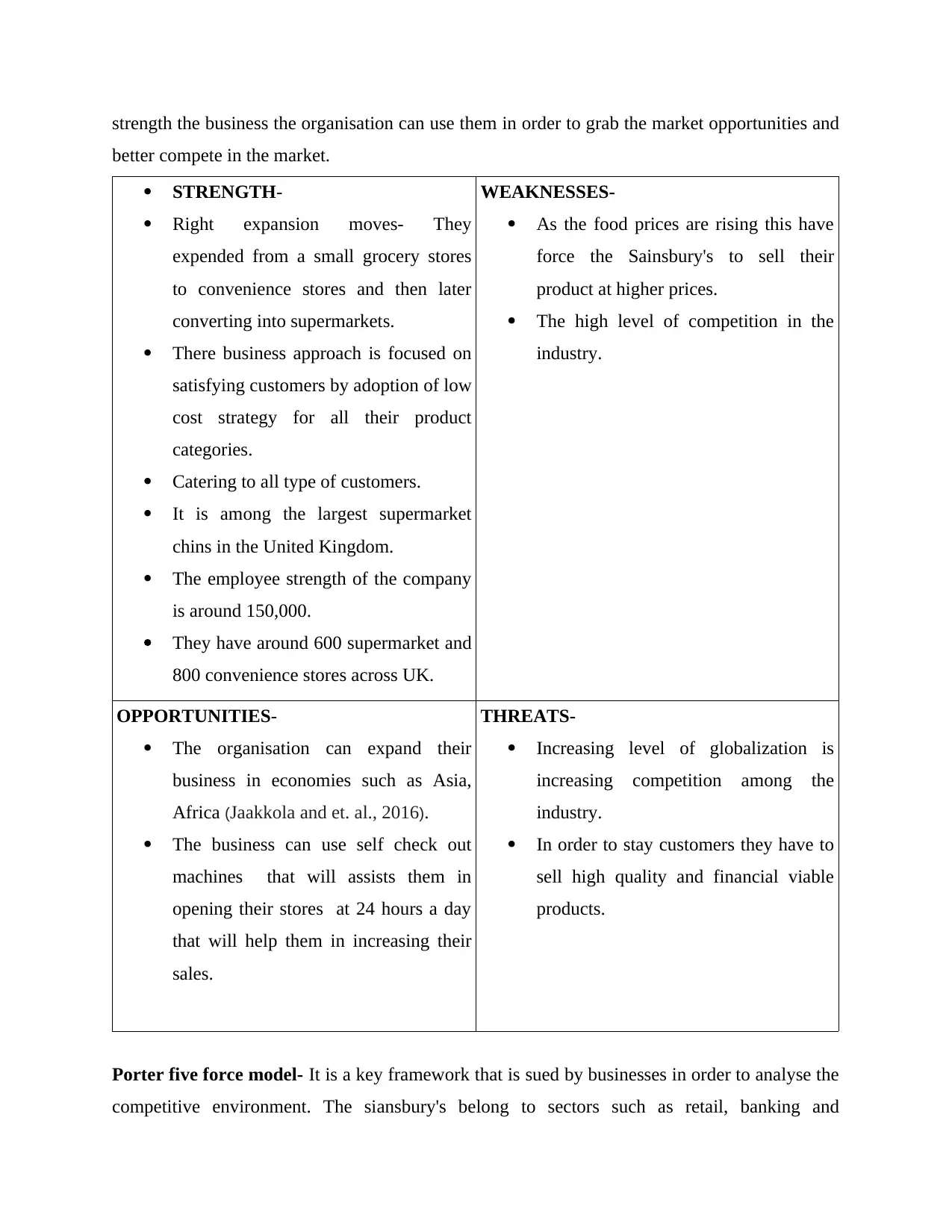
strength the business the organisation can use them in order to grab the market opportunities and
better compete in the market.
STRENGTH-
Right expansion moves- They
expended from a small grocery stores
to convenience stores and then later
converting into supermarkets.
There business approach is focused on
satisfying customers by adoption of low
cost strategy for all their product
categories.
Catering to all type of customers.
It is among the largest supermarket
chins in the United Kingdom.
The employee strength of the company
is around 150,000.
They have around 600 supermarket and
800 convenience stores across UK.
WEAKNESSES-
As the food prices are rising this have
force the Sainsbury's to sell their
product at higher prices.
The high level of competition in the
industry.
OPPORTUNITIES-
The organisation can expand their
business in economies such as Asia,
Africa (Jaakkola and et. al., 2016).
The business can use self check out
machines that will assists them in
opening their stores at 24 hours a day
that will help them in increasing their
sales.
THREATS-
Increasing level of globalization is
increasing competition among the
industry.
In order to stay customers they have to
sell high quality and financial viable
products.
Porter five force model- It is a key framework that is sued by businesses in order to analyse the
competitive environment. The siansbury's belong to sectors such as retail, banking and
better compete in the market.
STRENGTH-
Right expansion moves- They
expended from a small grocery stores
to convenience stores and then later
converting into supermarkets.
There business approach is focused on
satisfying customers by adoption of low
cost strategy for all their product
categories.
Catering to all type of customers.
It is among the largest supermarket
chins in the United Kingdom.
The employee strength of the company
is around 150,000.
They have around 600 supermarket and
800 convenience stores across UK.
WEAKNESSES-
As the food prices are rising this have
force the Sainsbury's to sell their
product at higher prices.
The high level of competition in the
industry.
OPPORTUNITIES-
The organisation can expand their
business in economies such as Asia,
Africa (Jaakkola and et. al., 2016).
The business can use self check out
machines that will assists them in
opening their stores at 24 hours a day
that will help them in increasing their
sales.
THREATS-
Increasing level of globalization is
increasing competition among the
industry.
In order to stay customers they have to
sell high quality and financial viable
products.
Porter five force model- It is a key framework that is sued by businesses in order to analyse the
competitive environment. The siansbury's belong to sectors such as retail, banking and
⊘ This is a preview!⊘
Do you want full access?
Subscribe today to unlock all pages.

Trusted by 1+ million students worldwide
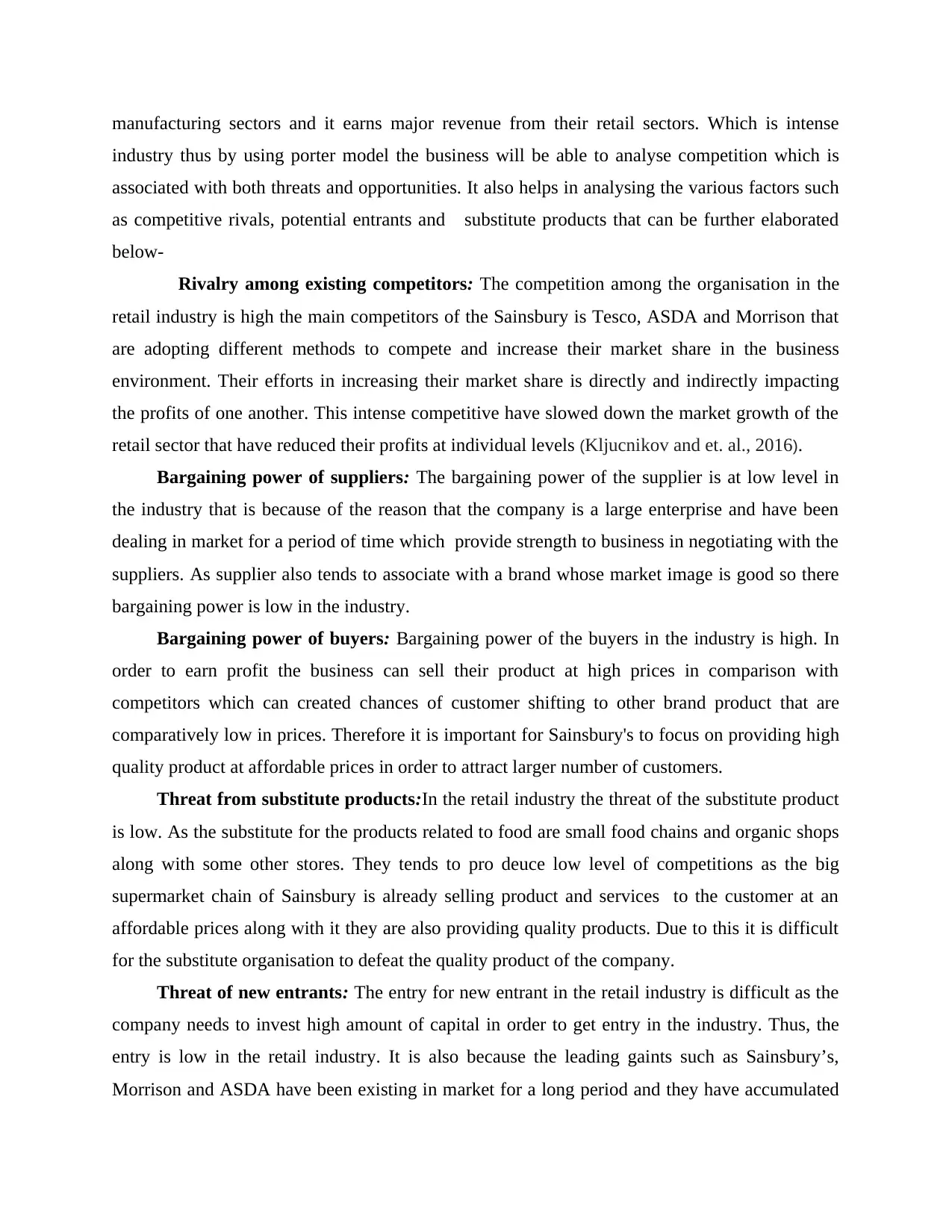
manufacturing sectors and it earns major revenue from their retail sectors. Which is intense
industry thus by using porter model the business will be able to analyse competition which is
associated with both threats and opportunities. It also helps in analysing the various factors such
as competitive rivals, potential entrants and substitute products that can be further elaborated
below-
Rivalry among existing competitors: The competition among the organisation in the
retail industry is high the main competitors of the Sainsbury is Tesco, ASDA and Morrison that
are adopting different methods to compete and increase their market share in the business
environment. Their efforts in increasing their market share is directly and indirectly impacting
the profits of one another. This intense competitive have slowed down the market growth of the
retail sector that have reduced their profits at individual levels (Kljucnikov and et. al., 2016).
Bargaining power of suppliers: The bargaining power of the supplier is at low level in
the industry that is because of the reason that the company is a large enterprise and have been
dealing in market for a period of time which provide strength to business in negotiating with the
suppliers. As supplier also tends to associate with a brand whose market image is good so there
bargaining power is low in the industry.
Bargaining power of buyers: Bargaining power of the buyers in the industry is high. In
order to earn profit the business can sell their product at high prices in comparison with
competitors which can created chances of customer shifting to other brand product that are
comparatively low in prices. Therefore it is important for Sainsbury's to focus on providing high
quality product at affordable prices in order to attract larger number of customers.
Threat from substitute products:In the retail industry the threat of the substitute product
is low. As the substitute for the products related to food are small food chains and organic shops
along with some other stores. They tends to pro deuce low level of competitions as the big
supermarket chain of Sainsbury is already selling product and services to the customer at an
affordable prices along with it they are also providing quality products. Due to this it is difficult
for the substitute organisation to defeat the quality product of the company.
Threat of new entrants: The entry for new entrant in the retail industry is difficult as the
company needs to invest high amount of capital in order to get entry in the industry. Thus, the
entry is low in the retail industry. It is also because the leading gaints such as Sainsbury’s,
Morrison and ASDA have been existing in market for a long period and they have accumulated
industry thus by using porter model the business will be able to analyse competition which is
associated with both threats and opportunities. It also helps in analysing the various factors such
as competitive rivals, potential entrants and substitute products that can be further elaborated
below-
Rivalry among existing competitors: The competition among the organisation in the
retail industry is high the main competitors of the Sainsbury is Tesco, ASDA and Morrison that
are adopting different methods to compete and increase their market share in the business
environment. Their efforts in increasing their market share is directly and indirectly impacting
the profits of one another. This intense competitive have slowed down the market growth of the
retail sector that have reduced their profits at individual levels (Kljucnikov and et. al., 2016).
Bargaining power of suppliers: The bargaining power of the supplier is at low level in
the industry that is because of the reason that the company is a large enterprise and have been
dealing in market for a period of time which provide strength to business in negotiating with the
suppliers. As supplier also tends to associate with a brand whose market image is good so there
bargaining power is low in the industry.
Bargaining power of buyers: Bargaining power of the buyers in the industry is high. In
order to earn profit the business can sell their product at high prices in comparison with
competitors which can created chances of customer shifting to other brand product that are
comparatively low in prices. Therefore it is important for Sainsbury's to focus on providing high
quality product at affordable prices in order to attract larger number of customers.
Threat from substitute products:In the retail industry the threat of the substitute product
is low. As the substitute for the products related to food are small food chains and organic shops
along with some other stores. They tends to pro deuce low level of competitions as the big
supermarket chain of Sainsbury is already selling product and services to the customer at an
affordable prices along with it they are also providing quality products. Due to this it is difficult
for the substitute organisation to defeat the quality product of the company.
Threat of new entrants: The entry for new entrant in the retail industry is difficult as the
company needs to invest high amount of capital in order to get entry in the industry. Thus, the
entry is low in the retail industry. It is also because the leading gaints such as Sainsbury’s,
Morrison and ASDA have been existing in market for a long period and they have accumulated
Paraphrase This Document
Need a fresh take? Get an instant paraphrase of this document with our AI Paraphraser
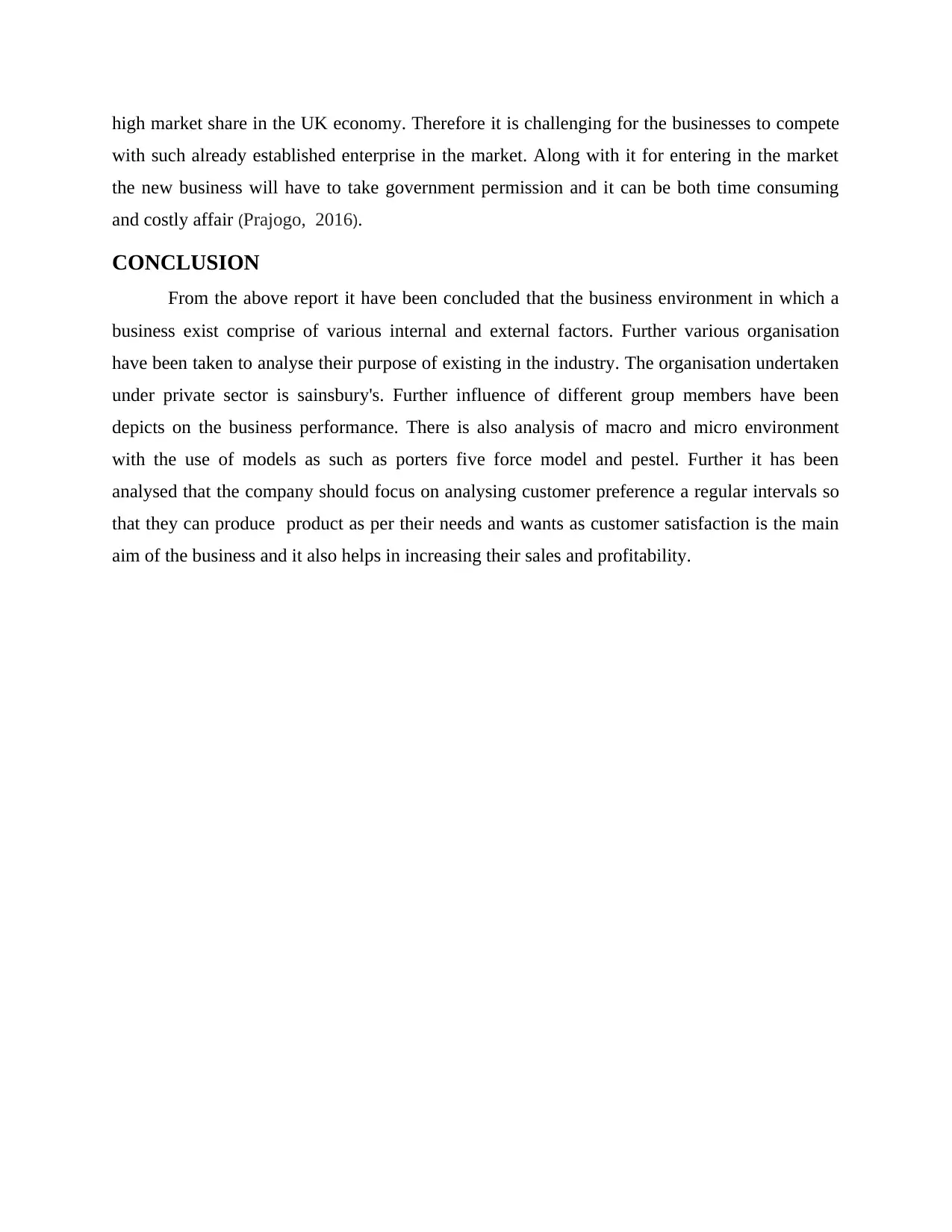
high market share in the UK economy. Therefore it is challenging for the businesses to compete
with such already established enterprise in the market. Along with it for entering in the market
the new business will have to take government permission and it can be both time consuming
and costly affair (Prajogo, 2016).
CONCLUSION
From the above report it have been concluded that the business environment in which a
business exist comprise of various internal and external factors. Further various organisation
have been taken to analyse their purpose of existing in the industry. The organisation undertaken
under private sector is sainsbury's. Further influence of different group members have been
depicts on the business performance. There is also analysis of macro and micro environment
with the use of models as such as porters five force model and pestel. Further it has been
analysed that the company should focus on analysing customer preference a regular intervals so
that they can produce product as per their needs and wants as customer satisfaction is the main
aim of the business and it also helps in increasing their sales and profitability.
with such already established enterprise in the market. Along with it for entering in the market
the new business will have to take government permission and it can be both time consuming
and costly affair (Prajogo, 2016).
CONCLUSION
From the above report it have been concluded that the business environment in which a
business exist comprise of various internal and external factors. Further various organisation
have been taken to analyse their purpose of existing in the industry. The organisation undertaken
under private sector is sainsbury's. Further influence of different group members have been
depicts on the business performance. There is also analysis of macro and micro environment
with the use of models as such as porters five force model and pestel. Further it has been
analysed that the company should focus on analysing customer preference a regular intervals so
that they can produce product as per their needs and wants as customer satisfaction is the main
aim of the business and it also helps in increasing their sales and profitability.
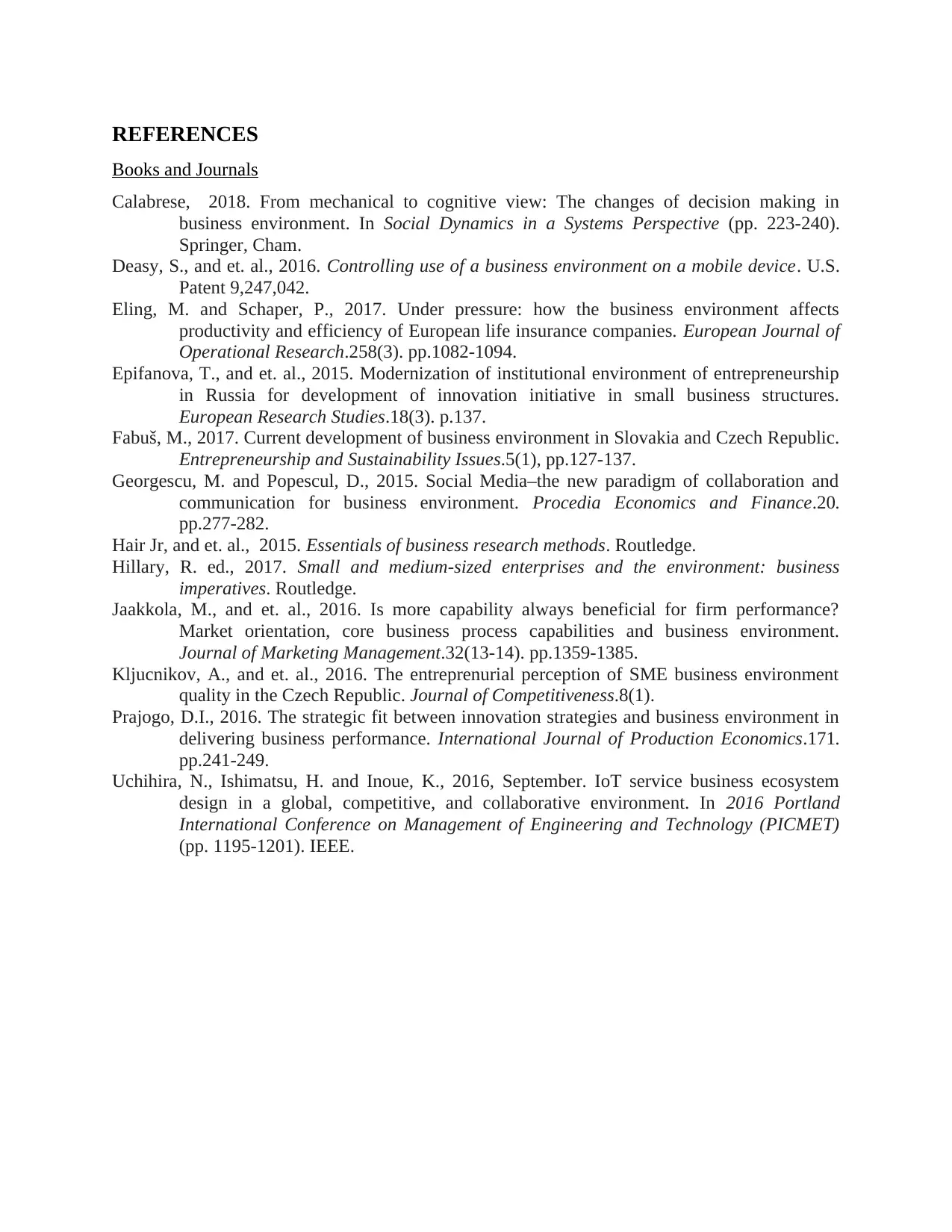
REFERENCES
Books and Journals
Calabrese, 2018. From mechanical to cognitive view: The changes of decision making in
business environment. In Social Dynamics in a Systems Perspective (pp. 223-240).
Springer, Cham.
Deasy, S., and et. al., 2016. Controlling use of a business environment on a mobile device. U.S.
Patent 9,247,042.
Eling, M. and Schaper, P., 2017. Under pressure: how the business environment affects
productivity and efficiency of European life insurance companies. European Journal of
Operational Research.258(3). pp.1082-1094.
Epifanova, T., and et. al., 2015. Modernization of institutional environment of entrepreneurship
in Russia for development of innovation initiative in small business structures.
European Research Studies.18(3). p.137.
Fabuš, M., 2017. Current development of business environment in Slovakia and Czech Republic.
Entrepreneurship and Sustainability Issues.5(1), pp.127-137.
Georgescu, M. and Popescul, D., 2015. Social Media–the new paradigm of collaboration and
communication for business environment. Procedia Economics and Finance.20.
pp.277-282.
Hair Jr, and et. al., 2015. Essentials of business research methods. Routledge.
Hillary, R. ed., 2017. Small and medium-sized enterprises and the environment: business
imperatives. Routledge.
Jaakkola, M., and et. al., 2016. Is more capability always beneficial for firm performance?
Market orientation, core business process capabilities and business environment.
Journal of Marketing Management.32(13-14). pp.1359-1385.
Kljucnikov, A., and et. al., 2016. The entreprenurial perception of SME business environment
quality in the Czech Republic. Journal of Competitiveness.8(1).
Prajogo, D.I., 2016. The strategic fit between innovation strategies and business environment in
delivering business performance. International Journal of Production Economics.171.
pp.241-249.
Uchihira, N., Ishimatsu, H. and Inoue, K., 2016, September. IoT service business ecosystem
design in a global, competitive, and collaborative environment. In 2016 Portland
International Conference on Management of Engineering and Technology (PICMET)
(pp. 1195-1201). IEEE.
Books and Journals
Calabrese, 2018. From mechanical to cognitive view: The changes of decision making in
business environment. In Social Dynamics in a Systems Perspective (pp. 223-240).
Springer, Cham.
Deasy, S., and et. al., 2016. Controlling use of a business environment on a mobile device. U.S.
Patent 9,247,042.
Eling, M. and Schaper, P., 2017. Under pressure: how the business environment affects
productivity and efficiency of European life insurance companies. European Journal of
Operational Research.258(3). pp.1082-1094.
Epifanova, T., and et. al., 2015. Modernization of institutional environment of entrepreneurship
in Russia for development of innovation initiative in small business structures.
European Research Studies.18(3). p.137.
Fabuš, M., 2017. Current development of business environment in Slovakia and Czech Republic.
Entrepreneurship and Sustainability Issues.5(1), pp.127-137.
Georgescu, M. and Popescul, D., 2015. Social Media–the new paradigm of collaboration and
communication for business environment. Procedia Economics and Finance.20.
pp.277-282.
Hair Jr, and et. al., 2015. Essentials of business research methods. Routledge.
Hillary, R. ed., 2017. Small and medium-sized enterprises and the environment: business
imperatives. Routledge.
Jaakkola, M., and et. al., 2016. Is more capability always beneficial for firm performance?
Market orientation, core business process capabilities and business environment.
Journal of Marketing Management.32(13-14). pp.1359-1385.
Kljucnikov, A., and et. al., 2016. The entreprenurial perception of SME business environment
quality in the Czech Republic. Journal of Competitiveness.8(1).
Prajogo, D.I., 2016. The strategic fit between innovation strategies and business environment in
delivering business performance. International Journal of Production Economics.171.
pp.241-249.
Uchihira, N., Ishimatsu, H. and Inoue, K., 2016, September. IoT service business ecosystem
design in a global, competitive, and collaborative environment. In 2016 Portland
International Conference on Management of Engineering and Technology (PICMET)
(pp. 1195-1201). IEEE.
⊘ This is a preview!⊘
Do you want full access?
Subscribe today to unlock all pages.

Trusted by 1+ million students worldwide
1 out of 12
Related Documents
Your All-in-One AI-Powered Toolkit for Academic Success.
+13062052269
info@desklib.com
Available 24*7 on WhatsApp / Email
![[object Object]](/_next/static/media/star-bottom.7253800d.svg)
Unlock your academic potential
Copyright © 2020–2025 A2Z Services. All Rights Reserved. Developed and managed by ZUCOL.





